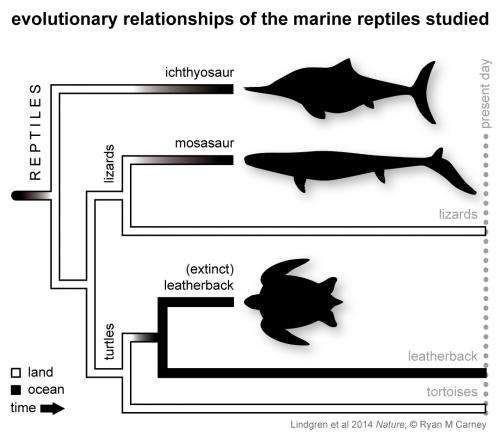Pigments reveal extinct reptiles' dark side

What did Tyrannosaurus rex really look like? Depending on which artist's impression you look at, the carnivorous king of the Cretaceous was a dull grey, an earthy brown, maybe a dark green... perhaps it was ochre, or even the colour of a bright lime.
New insights into prehistoric fossils, published on Wednesday, may one day help determine what the great dinosaurs looked like in real life.
Scientists said they had uncovered the first-ever traces of pigment in reptile fossils—a dark hue found in three extinct deep-sea beasts distantly related to today's leatherback turtle.
"This is the first time that... remains of original pigments have been detected in any (extinct) reptile, including dinosaurs," Johan Lindgren of Sweden's Lund University told AFP.
The next challenge will be to identify more pigments, helping palaeontologists to reconstruct the colouring of extinct animals.
"This finding potentially allows us to reconstruct the colours of T.rex in future," said Lindgren, though for now experts are limited to distinguishing dark areas from light ones.
Lindgren and colleagues studied molecular remains found on the skin of three marine monsters.
The samples came from a forerunner 55 million years ago of the leatherback turtle; a giant, finned lizard known as a mosasaur dated to 86 million years ago; and a toothy dolphin-like reptile called an ichthyosaur, around 190 million years old.

The remains took the form of micrometre (millionth of a metre) sized structures that, according to previous studies, were either pigment traces or the vestiges of bacteria.
The new investigation claims to settled that debate with in-depth microscopic analysis—revealing the remains to be traces of the most common skin pigment, melanin.
Colouration in the animal kingdom serves multiple purposes: from camouflage or sexual display to UV protection and heat retention.
Little is known about the colouring of long-extinct animals, given that pigmentation is carried in the quick-to-decay skin. But sometimes, as in this case, scientists are lucky to find soft tissue preserved as an "organic film".
The team pointed out there was a close correlation between the amount of melanin in skin, and the darkness of colour.
The fossil tissue of all three extinct sea beasts contained very tightly-packed pigment granules.
This led the scientists to conclude the creatures had "an overall dark colouration" similar to that of the modern leatherback turtle, whose top is almost entirely black, said Lindgren.

The find also throws up intriguing clues about how the ancient animals lived.
Like today's leatherback, the prehistoric reptiles may also have used their dark colouring to heat up quickly by basking at the ocean surface between dives.
The team said the ichthyosaur, like the modern sperm whale, was probably uniformly dark-coloured—unlike most living marine animals which have a dark back and light belly to provide camouflage against predators from above and below.
"This is fantastic!" said Lindgren. "When I started studying... in 1993, the film 'Jurassic Park' had just been released, and that was one of the main reasons why I got interested in biology and palaeontology.
"Then, 20 years ago, it was unthinkable that we would ever find biological remains from animals that have been extinct for many millions of years, but now we are there."
The study is published in the journal Nature.
More information: Paper: dx.doi.org/10.1038/nature12899
Journal information: Nature
© 2014 AFP




















